Abstract
The binding and biological activity of human TNF alpha on endothelial and tumour cells has been studied in the presence of monoclonal antibodies (MAbs). In particular, one monoclonal antibody to TNF alpha (MAb 32) has been identified which failed to inhibit binding and cytotoxicity of TNF alpha on WEHI-164 tumour cells but which was a potent inhibitor of TNF alpha-induced endothelial cell procoagulant activity on bovine aortic endothelial cells. The ability of MAb 32 to inhibit selectively the actions of TNF alpha on endothelial cells but not on tumour cells suggests a mechanism for enhancement of the anti-tumour action of TNF alpha in vivo when in complex with this antibody. Treatment of tumour bearing mice (WEHI-164 and Meth A fibrosarcoma) with TNF alpha-MAb 32 complex resulted in a 5- to 10-fold enhancement in the potency of the cytokine in comparison to free TNF alpha. Complexes between this cytokine and other MAbs generally resulted in either no effect or inhibition of TNF alpha activity in vivo and in vitro. Neither intact MAb 32 nor FAb' fragments of MAb 32 showed any tumour regressive activity in the absence of TNF alpha. The FAb' fragments were equipotent to the bivalent form of the antibody in enhancing TNF alpha activity. These data provide evidence that it is possible to segregate the individual biological activities of TNF alpha with concomitant enhancement of the tumour regressive activity of the cytokine in vivo.
Full text
PDF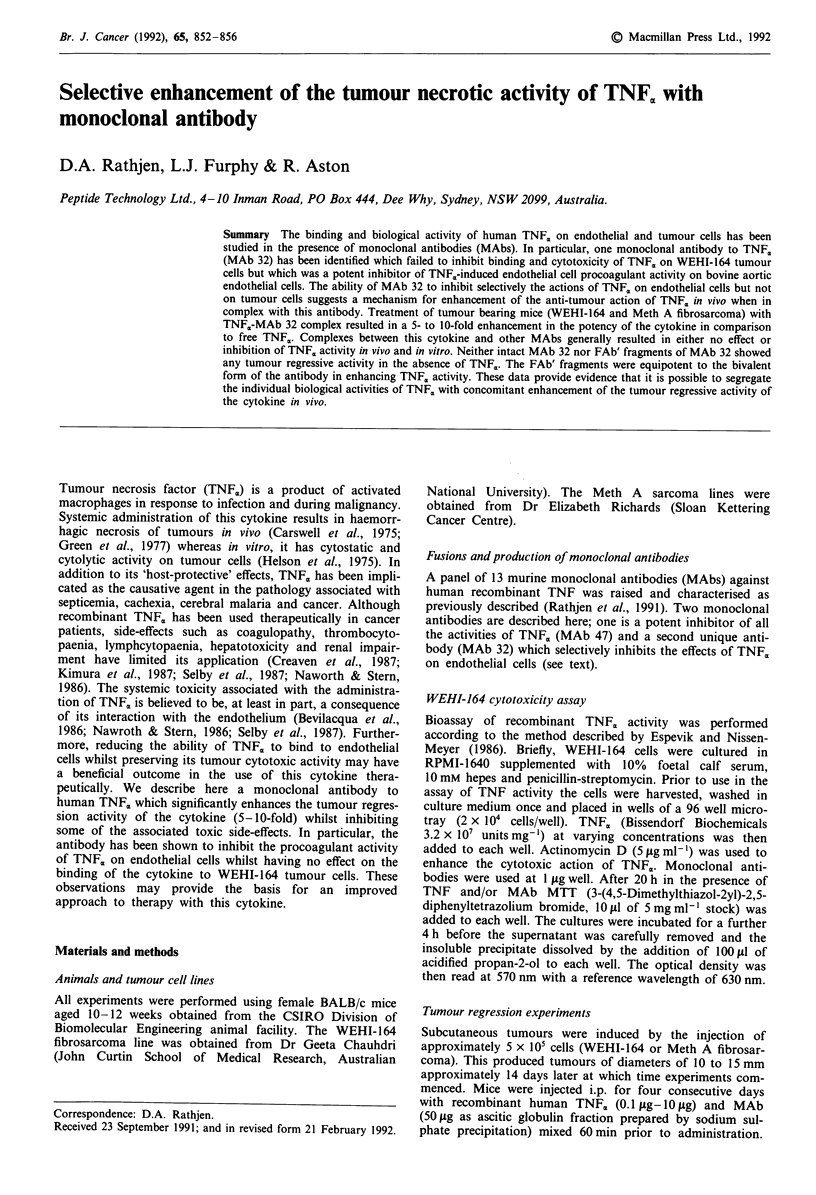
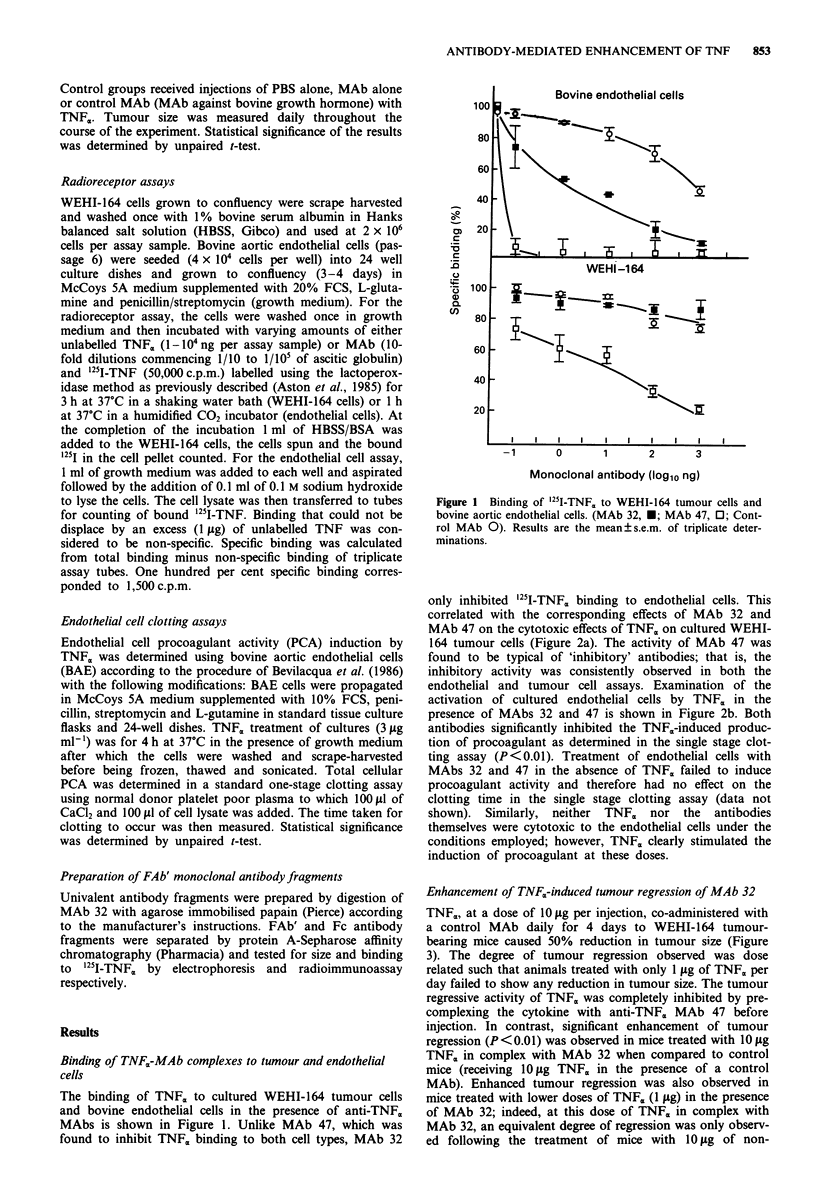
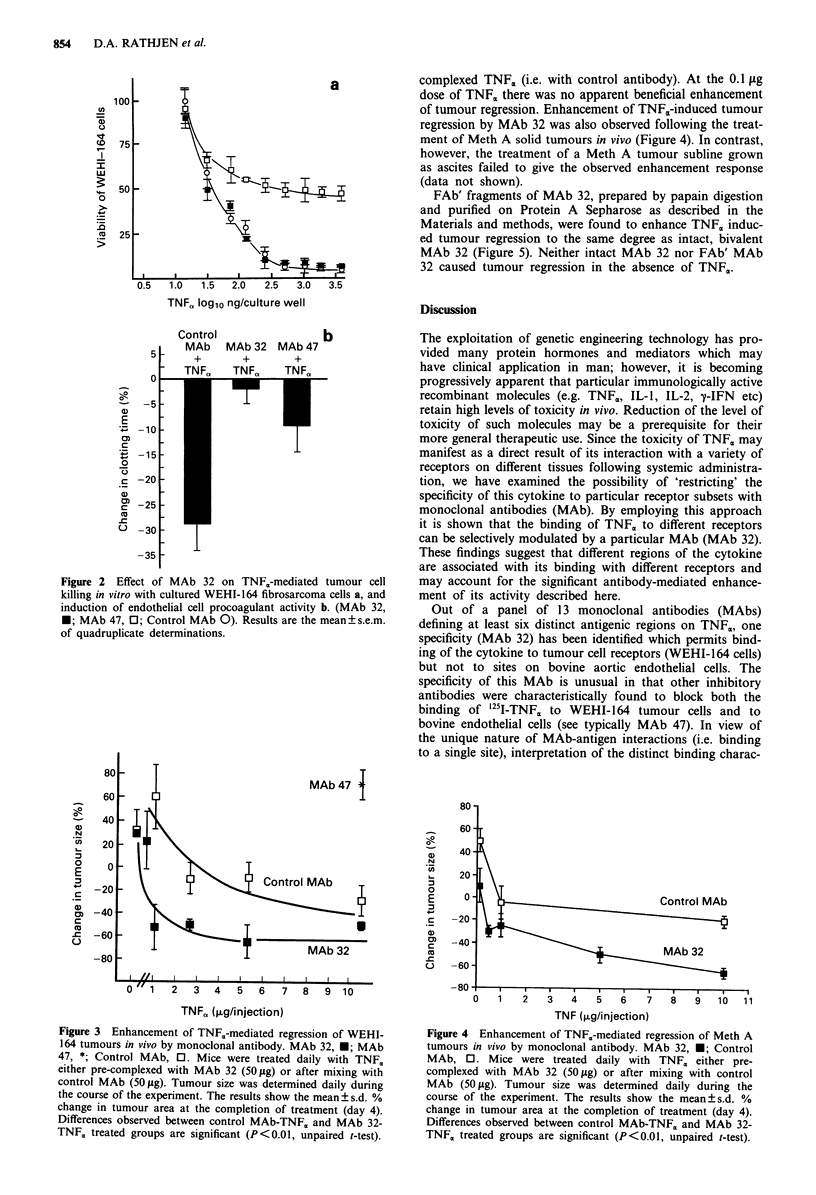
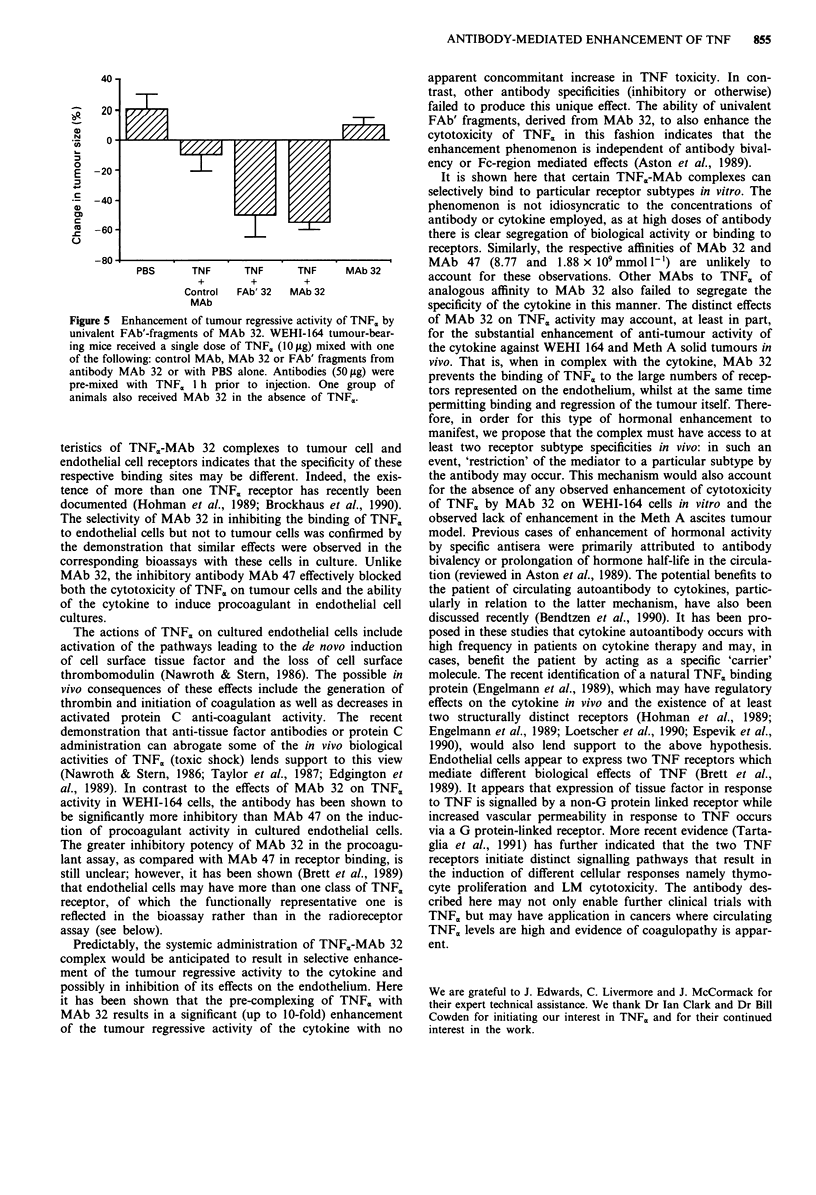
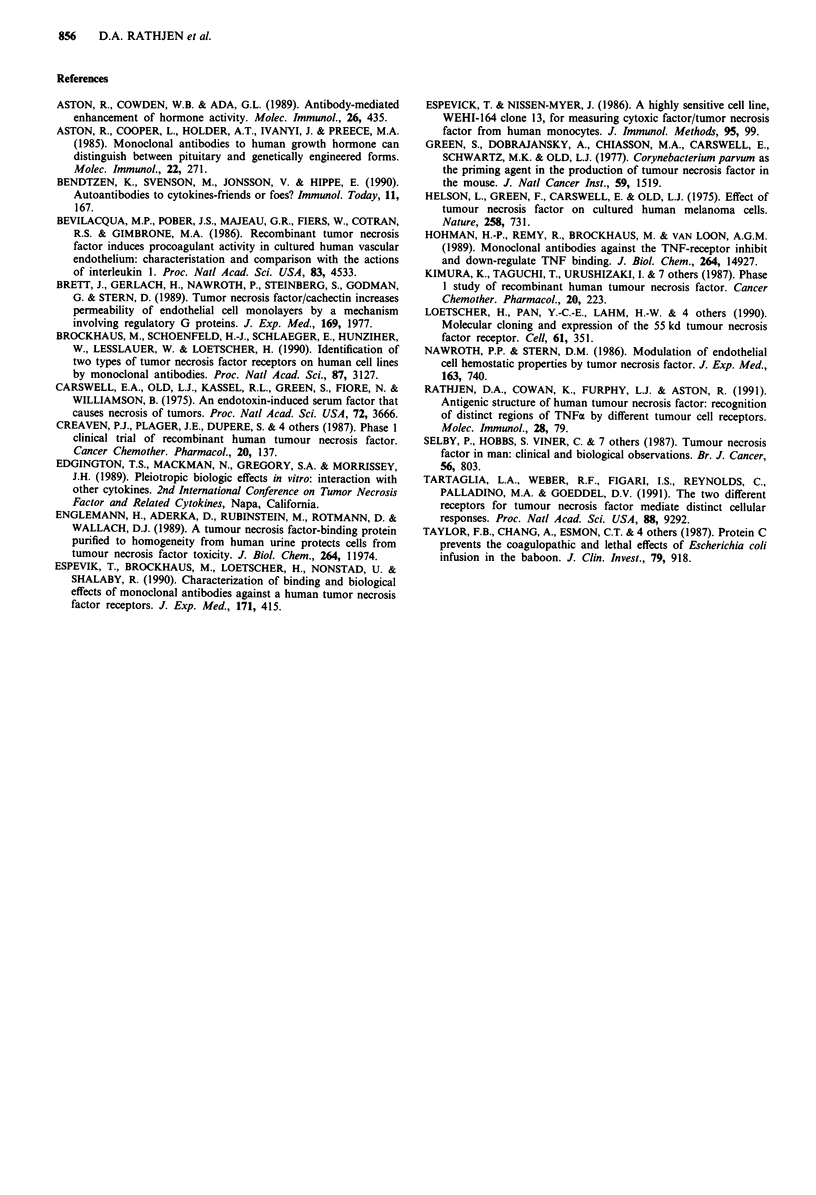
Selected References
These references are in PubMed. This may not be the complete list of references from this article.
- Aston R., Cooper L., Holder A., Ivanyi J., Preece M. Monoclonal antibodies to human growth hormone can distinguish between pituitary and genetically engineered forms. Mol Immunol. 1985 Mar;22(3):271–275. doi: 10.1016/0161-5890(85)90161-0. [DOI] [PubMed] [Google Scholar]
- Aston R., Cowden W. B., Ada G. L. Antibody-mediated enhancement of hormone activity. Mol Immunol. 1989 May;26(5):435–446. doi: 10.1016/0161-5890(89)90103-x. [DOI] [PubMed] [Google Scholar]
- Bendtzen K., Svenson M., Jønsson V., Hippe E. Autoantibodies to cytokines--friends or foes? Immunol Today. 1990 May;11(5):167–169. doi: 10.1016/0167-5699(90)90068-k. [DOI] [PubMed] [Google Scholar]
- Bevilacqua M. P., Pober J. S., Majeau G. R., Fiers W., Cotran R. S., Gimbrone M. A., Jr Recombinant tumor necrosis factor induces procoagulant activity in cultured human vascular endothelium: characterization and comparison with the actions of interleukin 1. Proc Natl Acad Sci U S A. 1986 Jun;83(12):4533–4537. doi: 10.1073/pnas.83.12.4533. [DOI] [PMC free article] [PubMed] [Google Scholar]
- Brett J., Gerlach H., Nawroth P., Steinberg S., Godman G., Stern D. Tumor necrosis factor/cachectin increases permeability of endothelial cell monolayers by a mechanism involving regulatory G proteins. J Exp Med. 1989 Jun 1;169(6):1977–1991. doi: 10.1084/jem.169.6.1977. [DOI] [PMC free article] [PubMed] [Google Scholar]
- Brockhaus M., Schoenfeld H. J., Schlaeger E. J., Hunziker W., Lesslauer W., Loetscher H. Identification of two types of tumor necrosis factor receptors on human cell lines by monoclonal antibodies. Proc Natl Acad Sci U S A. 1990 Apr;87(8):3127–3131. doi: 10.1073/pnas.87.8.3127. [DOI] [PMC free article] [PubMed] [Google Scholar]
- Carswell E. A., Old L. J., Kassel R. L., Green S., Fiore N., Williamson B. An endotoxin-induced serum factor that causes necrosis of tumors. Proc Natl Acad Sci U S A. 1975 Sep;72(9):3666–3670. doi: 10.1073/pnas.72.9.3666. [DOI] [PMC free article] [PubMed] [Google Scholar]
- Creaven P. J., Plager J. E., Dupere S., Huben R. P., Takita H., Mittelman A., Proefrock A. Phase I clinical trial of recombinant human tumor necrosis factor. Cancer Chemother Pharmacol. 1987;20(2):137–144. doi: 10.1007/BF00253968. [DOI] [PubMed] [Google Scholar]
- Engelmann H., Aderka D., Rubinstein M., Rotman D., Wallach D. A tumor necrosis factor-binding protein purified to homogeneity from human urine protects cells from tumor necrosis factor toxicity. J Biol Chem. 1989 Jul 15;264(20):11974–11980. [PubMed] [Google Scholar]
- Espevik T., Brockhaus M., Loetscher H., Nonstad U., Shalaby R. Characterization of binding and biological effects of monoclonal antibodies against a human tumor necrosis factor receptor. J Exp Med. 1990 Feb 1;171(2):415–426. doi: 10.1084/jem.171.2.415. [DOI] [PMC free article] [PubMed] [Google Scholar]
- Espevik T., Nissen-Meyer J. A highly sensitive cell line, WEHI 164 clone 13, for measuring cytotoxic factor/tumor necrosis factor from human monocytes. J Immunol Methods. 1986 Dec 4;95(1):99–105. doi: 10.1016/0022-1759(86)90322-4. [DOI] [PubMed] [Google Scholar]
- Green S., Dobrjansky A., Chiasson M. A., Carswell E., Schwartz M. K., Old L. J. Corynebacterium parvum as the priming agent in the production of tumor necrosis factor in the mouse. J Natl Cancer Inst. 1977 Nov;59(5):1519–1522. doi: 10.1093/jnci/59.5.1519. [DOI] [PubMed] [Google Scholar]
- Helson L., Green S., Carswell E., Old L. J. Effect of tumour necrosis factor on cultured human melanoma cells. Nature. 1975 Dec 25;258(5537):731–732. doi: 10.1038/258731a0. [DOI] [PubMed] [Google Scholar]
- Hohmann H. P., Remy R., Brockhaus M., van Loon A. P. Two different cell types have different major receptors for human tumor necrosis factor (TNF alpha). J Biol Chem. 1989 Sep 5;264(25):14927–14934. [PubMed] [Google Scholar]
- Kimura K., Taguchi T., Urushizaki I., Ohno R., Abe O., Furue H., Hattori T., Ichihashi H., Inoguchi K., Majima H. Phase I study of recombinant human tumor necrosis factor. Cancer Chemother Pharmacol. 1987;20(3):223–229. doi: 10.1007/BF00570490. [DOI] [PubMed] [Google Scholar]
- Loetscher H., Pan Y. C., Lahm H. W., Gentz R., Brockhaus M., Tabuchi H., Lesslauer W. Molecular cloning and expression of the human 55 kd tumor necrosis factor receptor. Cell. 1990 Apr 20;61(2):351–359. doi: 10.1016/0092-8674(90)90815-v. [DOI] [PubMed] [Google Scholar]
- Nawroth P. P., Stern D. M. Modulation of endothelial cell hemostatic properties by tumor necrosis factor. J Exp Med. 1986 Mar 1;163(3):740–745. doi: 10.1084/jem.163.3.740. [DOI] [PMC free article] [PubMed] [Google Scholar]
- Rathjen D. A., Cowan K., Furphy L. J., Aston R. Antigenic structure of human tumour necrosis factor: recognition of distinct regions of TNF alpha by different tumour cell receptors. Mol Immunol. 1991 Jan-Feb;28(1-2):79–86. doi: 10.1016/0161-5890(91)90089-3. [DOI] [PubMed] [Google Scholar]
- Selby P., Hobbs S., Viner C., Jackson E., Jones A., Newell D., Calvert A. H., McElwain T., Fearon K., Humphreys J. Tumour necrosis factor in man: clinical and biological observations. Br J Cancer. 1987 Dec;56(6):803–808. doi: 10.1038/bjc.1987.294. [DOI] [PMC free article] [PubMed] [Google Scholar]
- Tartaglia L. A., Weber R. F., Figari I. S., Reynolds C., Palladino M. A., Jr, Goeddel D. V. The two different receptors for tumor necrosis factor mediate distinct cellular responses. Proc Natl Acad Sci U S A. 1991 Oct 15;88(20):9292–9296. doi: 10.1073/pnas.88.20.9292. [DOI] [PMC free article] [PubMed] [Google Scholar]
- Taylor F. B., Jr, Chang A., Esmon C. T., D'Angelo A., Vigano-D'Angelo S., Blick K. E. Protein C prevents the coagulopathic and lethal effects of Escherichia coli infusion in the baboon. J Clin Invest. 1987 Mar;79(3):918–925. doi: 10.1172/JCI112902. [DOI] [PMC free article] [PubMed] [Google Scholar]


